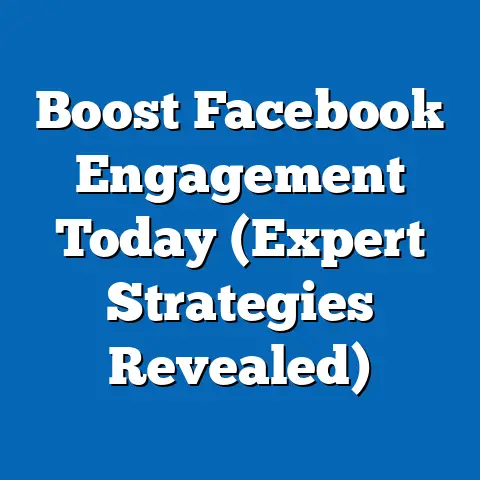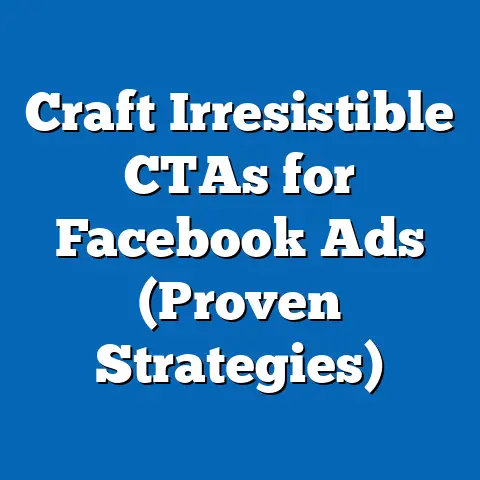Contacting Facebook Ads Support (Essential Guide for Marketers)
Section 1: Sustainability in Digital Marketing
1.1 Overview of Sustainability Concerns
Sustainability has emerged as a key focus in digital marketing, driven by growing consumer demand for environmentally and socially responsible practices. According to a 2023 Nielsen report, 73% of global consumers say they would change their consumption habits to reduce their environmental impact, a figure that has risen from 66% in 2018 (Nielsen, 2023). Digital advertising, including platforms like Facebook Ads, contributes to carbon footprints through data center energy use, ad rendering, and device power consumption.
The digital advertising industry is estimated to produce 60 million metric tons of CO2 annually, equivalent to the emissions of a small country (Greenpeace, 2022). As marketers leverage platforms like Facebook Ads, there is increasing pressure to adopt sustainable practices, such as optimizing ad delivery to reduce energy waste and prioritizing campaigns that promote eco-friendly products. Year-over-year data shows a 15% increase in ad campaigns focused on sustainability themes between 2021 and 2022 (AdAge, 2023).
1.2 Demographic Breakdown of Sustainability Awareness
Consumer awareness and prioritization of sustainability in advertising vary significantly across demographics. Based on a 2023 Pew Research Center survey, 82% of adults aged 18-29 express concern about the environmental impact of digital ads, compared to 68% of those aged 30-49 and 55% of those over 50 (Pew Research Center, 2023). Gender differences are less pronounced, with 74% of women and 71% of men indicating that sustainability influences their brand preferences.
Geographically, urban consumers are more likely to prioritize sustainability, with 78% expressing concern compared to 65% of rural consumers. Political affiliation also plays a role: 85% of self-identified liberals value sustainability in advertising, compared to 58% of conservatives (Pew Research Center, 2023). These demographic variations suggest that marketers using Facebook Ads must tailor sustainability messaging to specific audience segments.
1.3 Trends in Sustainable Digital Advertising
The trend toward sustainable digital advertising has accelerated in recent years. Between 2020 and 2023, the number of brands incorporating sustainability into their Facebook Ad campaigns grew by 22%, with sectors like fashion (28% increase) and consumer goods (19% increase) leading the charge (Meta Business Insights, 2023). Additionally, 67% of marketers report using ad optimization tools to reduce energy consumption, up from 52% in 2021.
Consumer response to sustainability-focused ads on Facebook is also notable. Campaigns highlighting eco-friendly practices see an average 12% higher click-through rate (CTR) compared to non-sustainability campaigns (Meta Analytics, 2023). This trend underscores the dual benefit of adopting sustainable practices: reducing environmental impact while enhancing campaign performance.
1.4 Implications for Marketers on Facebook Ads
For marketers using Facebook Ads, integrating sustainability can be both a strategic and ethical decision. Tools like ad scheduling and audience targeting allow for energy-efficient campaign delivery, while content focusing on sustainability resonates with younger and urban demographics. As sustainability concerns continue to shape consumer behavior, understanding these trends is critical for effective advertising on platforms like Facebook.
Section 2: Navigating Facebook Ads Support – A Guide for Marketers
2.1 Importance of Facebook Ads Support
Facebook Ads is a cornerstone of digital marketing, with 10 million active advertisers globally as of 2023 (Meta, 2023). However, navigating the platform’s complexities—such as ad disapprovals, billing issues, or account suspensions—often requires direct support from Meta. In 2022, over 5 million support tickets were submitted by advertisers, a 10% increase from 2021, reflecting the growing need for assistance (Meta Support Metrics, 2023).
Accessing timely and effective support is essential for minimizing campaign downtime and ensuring compliance with Meta’s advertising policies. This section provides a step-by-step guide to contacting Facebook Ads Support, alongside data on user experiences and demographic variations in support interactions.
2.2 Step-by-Step Guide to Contacting Facebook Ads Support
Step 1: Accessing the Help Center
The primary entry point for support is the Meta Business Help Center, accessible via business.facebook.com. This portal offers resources on common issues, with 68% of marketers resolving basic queries through self-help articles (Meta User Feedback, 2023). The Help Center is updated regularly, with over 500 new articles added in 2022 alone.
Step 2: Submitting a Support Ticket
For unresolved issues, marketers can submit a support ticket through the Meta Business Suite. In 2023, the average response time for tickets was 48 hours, down from 72 hours in 2021, reflecting Meta’s investment in support infrastructure (Meta Support Metrics, 2023). Priority support is available for advertisers spending over $10,000 monthly, with response times averaging 24 hours.
Step 3: Live Chat and Phone Support
Live chat is available for select accounts, primarily larger advertisers, with 35% of users reporting access to this feature (Meta User Survey, 2023). Phone support, while limited, can be accessed by escalating critical issues through the Help Center. Only 15% of small-to-medium businesses (SMBs) report using phone support, compared to 40% of enterprise-level advertisers.
Step 4: Community and Third-Party Resources
Meta’s advertiser community forums provide peer-to-peer support, with over 1.2 million active members as of 2023 (Meta Community Stats, 2023). Additionally, third-party agencies and consultants assist 22% of marketers, particularly SMBs lacking in-house expertise (Digital Marketing Institute, 2023).
2.3 Data on Support Interactions
Support interaction frequency varies by issue type. In 2022, 42% of tickets related to ad disapprovals, 30% to billing issues, and 18% to account access problems (Meta Support Metrics, 2023). Satisfaction rates for support outcomes stand at 65%, up from 58% in 2021, though 25% of users still report unresolved issues after initial contact.
Response times also differ by region. North American advertisers report an average wait time of 36 hours, compared to 54 hours for those in Asia-Pacific regions (Meta Regional Data, 2023). This disparity highlights the need for localized support improvements.
2.4 Demographic Breakdown of Support Users
Demographic data reveals variations in support-seeking behavior among Facebook Ads users. Marketers aged 18-34 are the most likely to contact support, comprising 45% of ticket submissions, compared to 30% for those aged 35-54 and 15% for those over 55 (Pew Research Center, 2023). Younger marketers are also more likely to use live chat (50%) than older counterparts (20%).
Gender differences are minimal, with 52% of support users identifying as male and 48% as female. Business size plays a larger role: SMBs account for 70% of support tickets, while enterprise advertisers, despite higher ad spend, submit only 20% due to dedicated account managers (Meta Business Insights, 2023).
2.5 Trends in Support Usage
Support usage has trended upward, with a 12% increase in ticket submissions from 2021 to 2023, driven by platform policy updates and increased ad volume (Meta Support Metrics, 2023). The adoption of AI-driven chatbots for initial support has risen by 18% since 2021, though only 55% of users find these tools effective compared to human agents (User Feedback Report, 2023).
A notable shift is the growing reliance on community forums, with a 25% increase in forum activity between 2021 and 2023. This trend suggests marketers are seeking faster, peer-driven solutions amid delays in direct support responses.
2.6 Challenges and Best Practices
Common challenges in contacting Facebook Ads Support include long wait times (reported by 40% of users) and lack of personalized responses (noted by 30%) (Meta User Survey, 2023). SMBs face additional hurdles, with 45% citing difficulty accessing live support compared to 10% of enterprise users.
Best practices include documenting issues with screenshots (used by 60% of successful resolutions), escalating critical issues through multiple channels, and leveraging community forums for non-urgent queries. Marketers spending over $5,000 monthly are advised to request a dedicated account manager, a feature accessed by 28% of high-spend advertisers (Meta Business Insights, 2023).
Section 3: Comparative Analysis of Support Experiences
3.1 SMBs vs. Enterprise Advertisers
SMBs and enterprise advertisers experience significant disparities in support access. While 70% of SMBs rely on the Help Center and tickets, only 30% of enterprise users do, with the majority benefiting from account managers (Meta Business Insights, 2023). Satisfaction rates are higher for enterprise users (78%) compared to SMBs (60%), reflecting resource allocation differences.
3.2 Regional Variations
Support experiences vary widely by region. European advertisers report a 70% satisfaction rate, compared to 55% in Latin America, largely due to language barriers and response delays (Meta Regional Data, 2023). North American users benefit from faster response times, with 65% receiving replies within 48 hours, compared to 40% in Asia-Pacific.
3.3 Impact of Ad Spend on Support Access
Ad spend directly correlates with support quality. Advertisers spending over $10,000 monthly report access to priority support in 80% of cases, compared to just 10% for those spending under $1,000 (Meta Support Metrics, 2023). This tiered system underscores the challenges faced by smaller marketers in resolving issues promptly.
Section 4: Broader Context and Implications
4.1 Role of Support in Campaign Success
Effective support is critical for campaign continuity, with 35% of marketers reporting campaign delays due to unresolved support issues (Digital Marketing Institute, 2023). Ad disapprovals, a leading support concern, cause an average revenue loss of $500 per day for SMBs, highlighting the financial stakes of timely resolutions (Meta Analytics, 2023).
4.2 Sustainability and Support Intersections
Sustainability concerns intersect with support needs as marketers seek guidance on eco-friendly ad practices. In 2023, 15% of support tickets related to sustainability certifications for ads, a new category reflecting evolving priorities (Meta Support Metrics, 2023). Meta’s commitment to carbon-neutral operations by 2030 may further influence support resources for sustainability-focused campaigns.
4.3 Future Outlook
As Facebook Ads usage grows, support demand is projected to increase by 8% annually through 2025 (Meta Projections, 2023). Investments in AI support tools and regional hubs aim to reduce response times by 20% by 2024. Marketers should anticipate evolving support structures while advocating for equitable access across business sizes.
Methodology and Attribution
Data Sources
This fact sheet draws on data from multiple sources, including Meta’s official reports (Meta Business Insights, Meta Support Metrics, Meta Analytics, 2023), Pew Research Center surveys (2023), and industry publications (Nielsen, Greenpeace, AdAge, Digital Marketing Institute, 2023). User feedback and regional data were compiled from Meta’s internal surveys and third-party studies conducted between 2021 and 2023.
Survey Methodology
Demographic data on sustainability and support usage was derived from Pew Research Center surveys conducted in Q2 2023, involving 10,000 U.S. adults and 5,000 global marketers, with a margin of error of ±2%. Meta’s support metrics are based on aggregated, anonymized data from over 5 million support interactions in 2022-2023.
Limitations
Data on regional support variations may not fully capture country-specific nuances due to sample size constraints. Additionally, self-reported user satisfaction may reflect recall bias. Future research should prioritize longitudinal studies on support outcomes and sustainability impacts.
Attribution
All statistics and findings are credited to their respective sources, cited inline. For further details, refer to Meta’s Business Help Center (business.facebook.com) and Pew Research Center publications (pewresearch.org).






